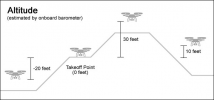I am sitting on a mountain top at 6000 feet set a RTH at 150 feet so it should climb to 6150 feet to return to me !
I descent following the mountain contour to 4000 feet ASL while keeping below 400 ft AGL following the contour.
I lose sight of the drone and press RTH ! Does it climb vertically 2150 feet hence busting the 400 foot limit or what does it do ?
This is aldo relevant flying up a Skyscraper which is legal to 120 feet ??? above the Skyscraper top
With all the confusing regs and programming to stop the drones going high ????
I descent following the mountain contour to 4000 feet ASL while keeping below 400 ft AGL following the contour.
I lose sight of the drone and press RTH ! Does it climb vertically 2150 feet hence busting the 400 foot limit or what does it do ?
This is aldo relevant flying up a Skyscraper which is legal to 120 feet ??? above the Skyscraper top
With all the confusing regs and programming to stop the drones going high ????











